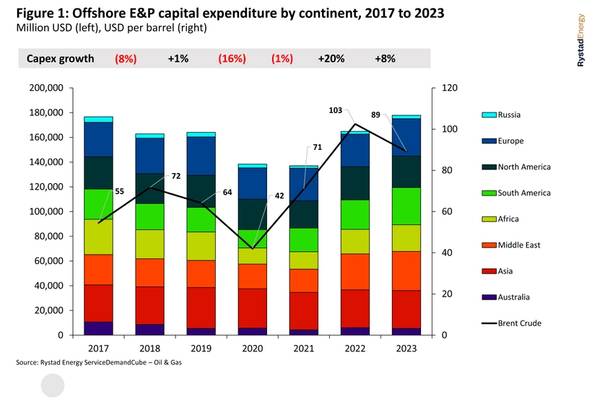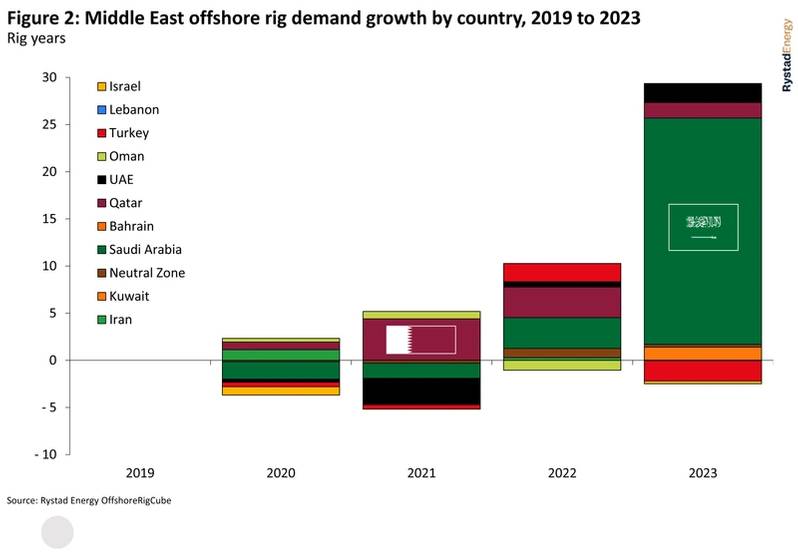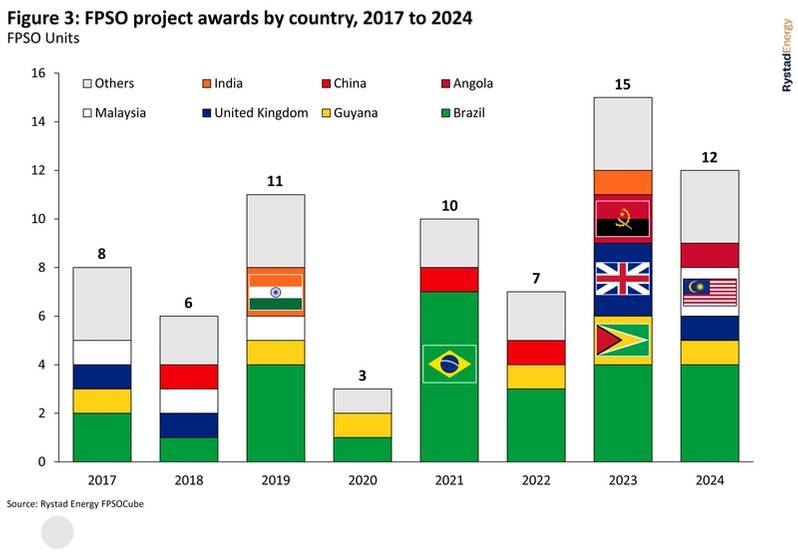

Offshore exploration and production (E&P) capital expenditures (capex) will shake off the pandemic-induced declines of the past two years and rebound by 20% in 2022, reaching a total $165 billion spent on exploration, wells, and facilities (Figure 1).
This is slightly less than half the all-time high for offshore E&P investment of $332 billion in 2014, set at a time when the average Brent crude oil price had stayed above $100 per barrel for a fourth consecutive year. Following several years of lower crude prices and demand uncertainty, crude has jumped again this year to average over $100 per barrel.
While Brent prices have cooled from a peak of $128 earlier this year, demand is expected outstrip supply beginning in December this year and lasting through the end of 2023, translating into an average price of $89 per barrel next year. This is largely driven by the EU embargo on Russian oil which takes effect on 5 December, constraining Russian exports by limiting the fleet of tankers to deliver crude to “friendly” countries including India and mainland China. In addition, natural gas takeaway capacity and capital discipline in an environment of high service price inflation are expected to limit the growth of US oil production. With this outlook for crude prices, offshore E&P operators are expected to continue investing in production, lifting capex by another 8% to $178 billion next year.
Since the offshore spending peak in 2014, operators have shifted their capital projects toward short-cycle investments, including shale and other tight resource plays in North America, which quickly boost short-term production, similar to infill drilling in proven geologic areas. In a sustained high commodity price environment, operators now feel more confident deploying capital into long-cycle offshore developments, like we saw in the last offshore investment cycle. These investments can take the form of seismic and FEED activity as well as more concrete investments in new wells and offshore facilities.
In the offshore drilling arena, state-owned producers including Saudi Aramco, ADNOC, QatarEnergy, and Petrobras are taking a lead in well construction, aided by international majors and other operators. One particular region of increased activity is the Middle East (Figure 2), where Saudi-backed driller ADES and UAE-supported ADNOC Drilling have spent the past couple years expanding their fleets, acquiring dozens of new and used jackup rigs to drill in the shallow waters of the Persian Gulf. Zooming in on Middle East rig demand, we see that the vast majority of year-on-year growth will come from Saudi Arabia, adding 24 rig years on top of 2022 levels. The entire region is expected to grow by 23% from a base of 118 rig years for this year, already 10% higher than 2021. In terms of rig years, the Middle East is by far the biggest growth region in 2023, followed by South America and West Africa which are projected to add 7.3 and 3.3 offshore rig years, respectively.
 Courtesy Rystad Energy
Courtesy Rystad Energy
Growth in South America will be concentrated in the deepwater areas of Brazil and Guyana, led by Petrobras and ExxonMobil, with shelf activity only accounting for a small minority of the capital spending. Rather than shallow-water platforms, these developments will require massive floating production, storage and offloading (FPSO) vessels and complex subsea production systems. Based on standardized hull, topside, and mooring designs by SBM Offshore and MODEC, the largest newbuild FPSOs feature up to 2.3 million barrels of storage and 50,000 tonnes of topsides. Globally, seven FPSO projects have been awarded this year, with an additional 15 to be awarded in 2023 and another 12 in 2024 (Figure 3).Brazil has been the dominant FPSO market over the past several years with just over one-third of FPSO awards over the 2017 to 2024 period. In addition to four projects in Brazil, next year will see three awards in the UK, two in Guyana, and two in Angola. In South America, subsea capex is expected to exceed $10 billion as these operators build out the infrastructure needed to support massive offshore oil fields such as Buzios, Bacalhau, and Jubarte in Brazil and Yellowtail, Payara, and Pacora in Guyana.
 Courtesy Rystad Energy
Courtesy Rystad Energy
With crude oil and natural gas prices expected to stay elevated through 2023, offshore spending on oilfield services will further extend beyond 2022 levels. State operators aiming to extract valuable resources in advance of the eventual energy transition will lead the way, along with international majors which now feel confident investing in long-cycle offshore projects in core basins to grow production in a high-price environment.